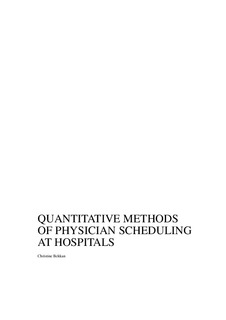| dc.description.abstract | Staff scheduling at hospitals is a widely studied area within the fields of operation
research and management science because of the cost pressure on hospitals. There is
an interest to find procedures on how to run a hospital more economically and
efficient. Many of the studies about staff scheduling at hospital have been done about
nurses, which work under common labor law restrictions. The goal of nurse
scheduling is to minimize the staffing cost and maximizing their preferences. While
the operation rooms are the engine of the hospitals, the physicians are the fueling for
the hospitals. Without the physicians the patients would not be treated well and the
hospital would not earn money.
This thesis studies the physician scheduling problem, which has not been studied so
widely as the nurse scheduling problem. A limited number of literatures about this
theme have been studied to answer the main research question:
How can we categorize physician scheduling at hospitals?
Studying the physician rostering problem on the search for efficiency and cost
savings is an intricate process. One can read a lot about this theme develop a lot of
models; and shape and test different hypotheses. However, to increase efficiency it is
wise to make a plan of information to consider.
The categories searched for within this literature review are the level of experience,
the planning period, the field of specialty, the type of shifts, whether cyclic or acyclic
schedules are used and also which models and methods are used to solve this
problem.
Level of experience was first divided between residents - that are still under
education, and physicians - which are fully licensed. Physicians are medical trained
doctors that provide medical treatment rather than surgical treatment in hospitals.
After medical school, they have accomplished between three to seven years of
residential internship before they obtain their license. The residents are still under
education and must therefore participate in a number of assorted activities and
patient treatments during their resident period to acquire their license. This situation for resident makes scheduling unique as they are in a learning period and staffing the
hospital at the same time.
The planning period is a category that is divided in three levels; short-term which
lasts up to a month, midterm which lasts from one month up to six months and a
long-term that lasts from six months up to one year.
The field of specialty is divided between the specialties of the physicians. In the
numerous departments at a hospital, the work is distinctive from one another. A
normal workday in a department that is only open during the day can be quite
different from a workday in an emergency department.
Working in a hospital is unlike other type of jobs. A hospital or at least different
departments in a hospital are open all day long, every day of the year. As a result, the
hospital must be staffed all the time. The need for staffing varies during the day, the
day of week; and during the different seasons, due to the fluctuation of the demands.
An example for a solution is a variety of broad types of shifts. Scheduling these shift
types can be made cyclic or acyclic.
Qualitative method has been used in this master’s thesis. The research question is a
typically quantitative method starting with “how”. And to answer it, this thesis builds
on a definite number of case studies. These case studies are limited to concern only
about physician and resident scheduling problem written in English. These cases are
primarily scientific articles and conference handouts. The cases are read - and
interesting information is registered in a case study database.
The findings have shown different use of planning period after the level of
experience. Few studies have been done with short-term planning period; physicians
are mostly scheduled for a midterm planning period, whereas residents are mostly
scheduled with a long-term planning period.
Most studies have scheduled physicians and residents for a day, evening and night
shift, often in a combination with some kind of on-call shift. The field of specialty
that is most studied is within emergency medicine. As the work in an emergency department is stressful, it is a complex task to make good schedules that satisfies the
physicians and residents working there.
Exact approaches are the most used modeling technique used for physician
scheduling. | en_US |
